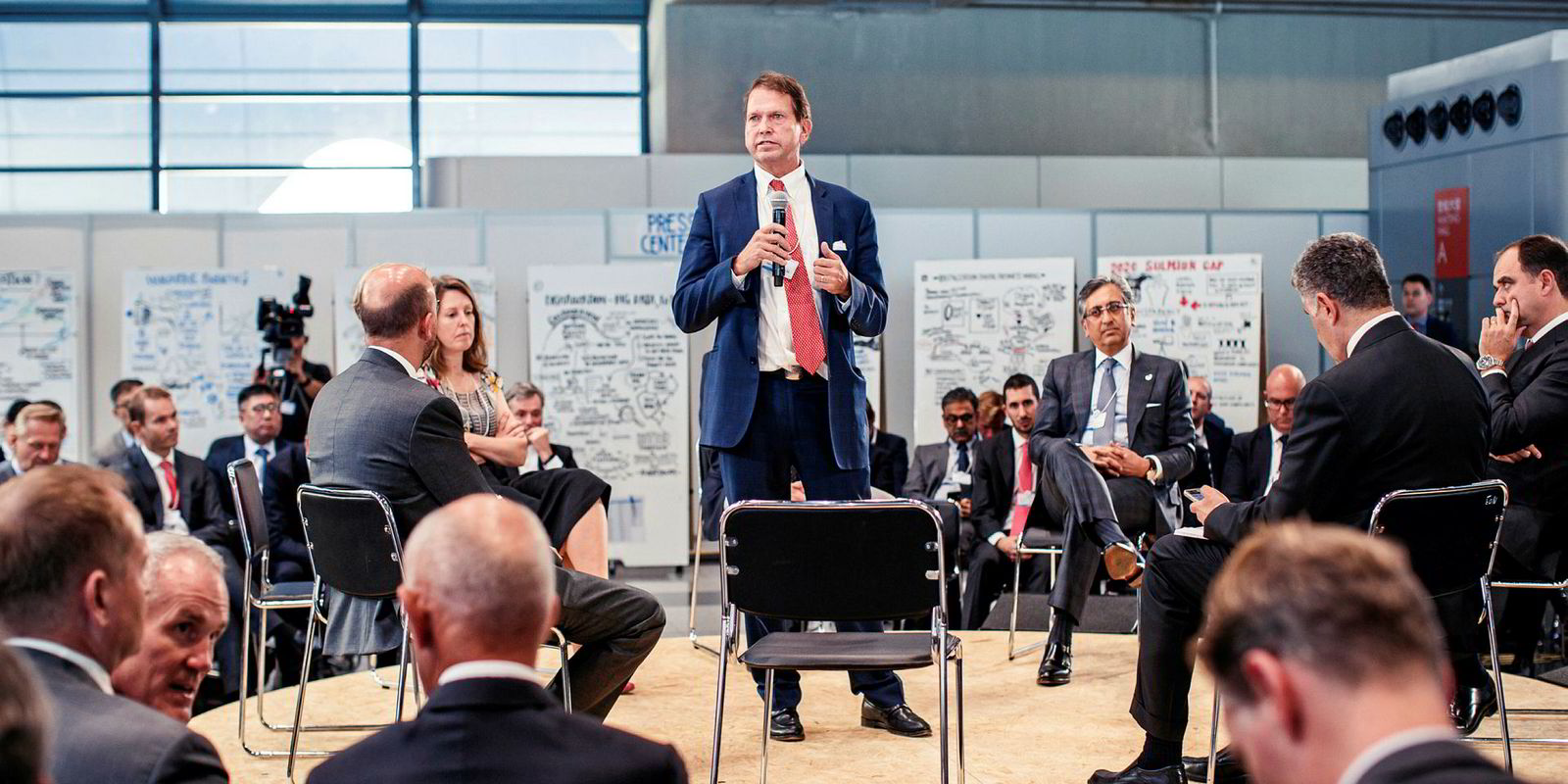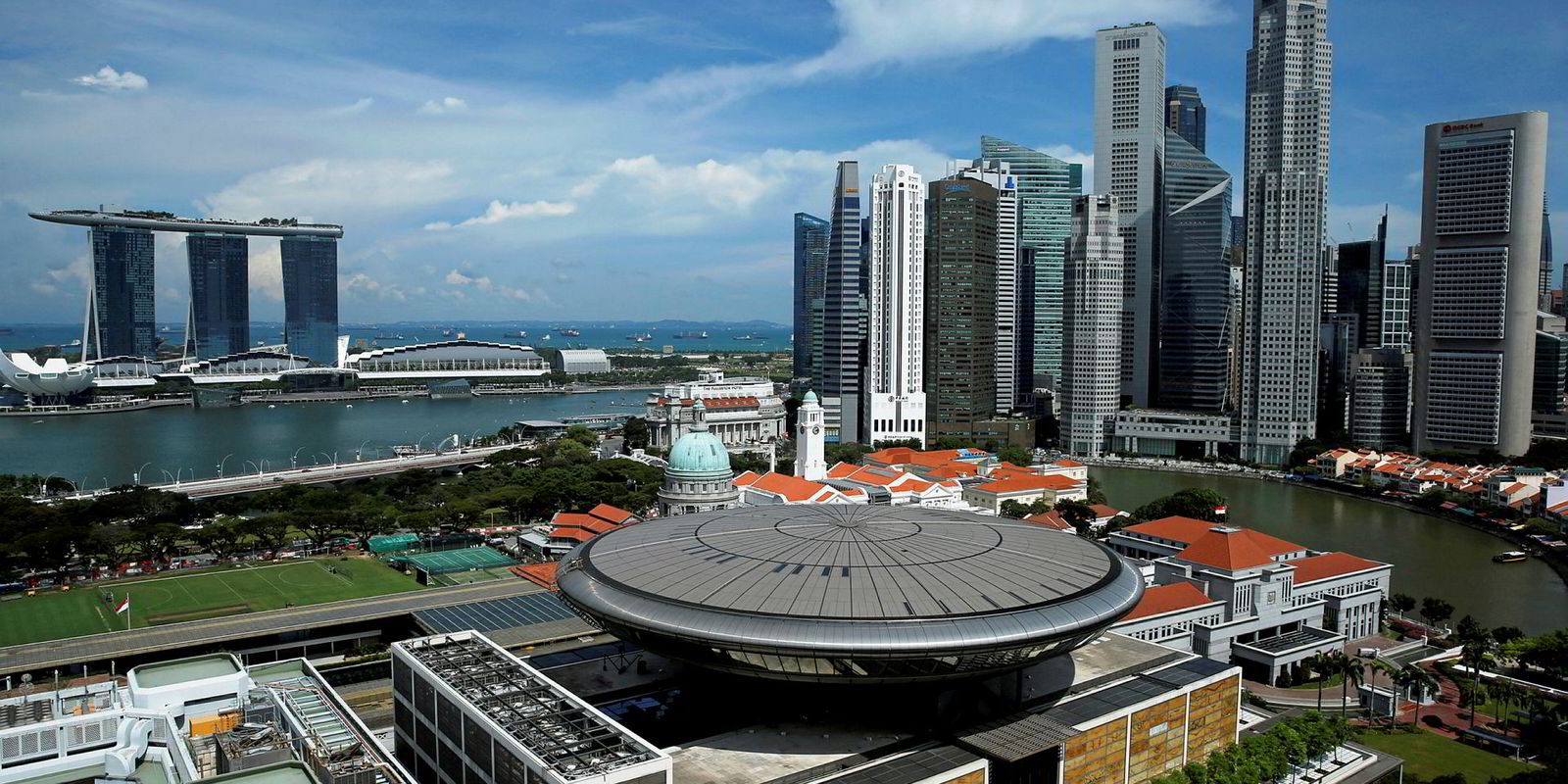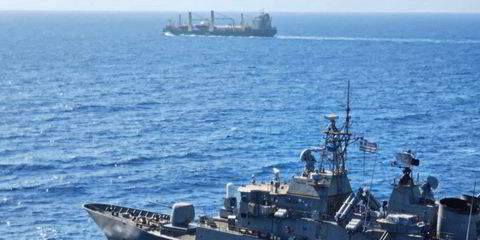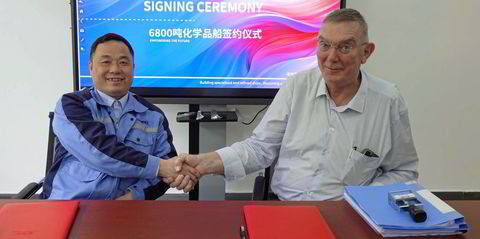While compliance with looming sulphur rules may provide supply-side support by taking ships out of the market for retrofit or demolition, tankers are also expected to see a shift in trade lanes.
Many in the sector view this change with optimism.
As some vessels are scrapped or enter repair yards, others may be pressed into storage duties, tanker industry participants say in TradeWinds' annual look at the year ahead. Refineries gearing up to deliver more low-sulphur fuel is expected to provide more good news for the wet sector in the year ahead.
Captain Nasrollah Sardashti
Managing director, National Iranian Tanker Co
The 2020 sulphur cap will be a challenge for the whole marine industry due to a potential lack of compliant fuel and limited scrubber production. Requirements for environmental and emissions compliance will be a driving force in pushing older vessels out of the market. The costs for installing scrubbers make it irrational to fit them on older vessels.
It is important to note that open-loop systems are being banned from a number of places now, which means that these owners will need to operate on alternative fuels also when calling at such ports or countries, despite them having a scrubber
Captain Nasrollah Sardashti
Of the scrubbers being installed, the vast majority are open-loop systems. It is important to note that open-loop systems are being banned from a number of places now, which means that these owners will need to operate on alternative fuels when calling at such ports or countries, despite having a scrubber.
The outlook would therefore suggest potential new trading routes. Owners could become more attracted to the storage business due to increased fuel costs. The industry can expect increased demolition of middle-aged tankers and slow steaming, which all means a greater need in total for tankers.
The concept of installing a scrubber involves various matters, including capital costs and the time for installation. Also to be taken into consideration are regulatory changes in the future, for example the banning open-loop systems.
Overall, it does not seem an appropriate option for vessels over 15 years old, or even 10 years, hence suggesting that these vessels will survive on using low-sulphur fuel instead. One should also take into account the higher fuel consumption of older vessels, which in effect means higher fuel costs. This will make them less favourable to the market.
Outlook depends on fuel
It is impossible to know how the tanker sector will perform without knowing what the availability of low-sulphur fuel and its cost will be.
In 2015, rules came into force in the North West European market requiring low-sulphur fuel (maximum 0.1%)
be used. Prior to this, the debate was similar to what is heard today – the price of low-sulphur fuel would rise sharply, costs of transportation would rise and be passed on to charterers and in the end consumers, hurting the economy. Very little of this happened.
Although the experience from the European market post-2015 is no guarantee that a similar situation will play out globally post-2020, this is a bet which most shipowners will be faced with as a relatively small portion of the global fleet is, or will have been, fitted with scrubbers or LNG propulsion by that time.

Paddy Rodgers
Chief executive, Euronav
Preparations for IMO 2020 are likely to drive positive disruption for the crude tanker sector through reduced supply capacity for three reasons.
With fuel costs rising, higher fuel consuming older tonnage will come under increased pressure to exit the fleet. With supportive steel prices, compressed cash earnings and 100 VLCCs already over 17 years of age, more large tankers should be recycled.
Secondly, the 60 to 80 VLCC scheduled to voluntarily leave the market to retrofit scrubbers during 2019 will impact on fleet capacity growth, even during a year of elevated newbuild delivery.
Thirdly, preparation at all levels of shipping and storage is likely to disrupt some usual patterns of trade over the coming 12 months, as oil will need incremental segregation by sulphur content.
The refiners have repeatedly assured that there will be sufficient compliant fuel when the new rules kick in on 1 January 2020.
The sector’s challenges will be more logistical in our view as IMO 2020 will segregate the barrel based on its sulphur content — this will require more storage and infrastructure throughout the crude supply chain. Minimising delays and congestion during this phase will be difficult.
Bunker quality issues in both compliant fuel and the remaining heavy fuel oil (as the remaining fuel pool will be more sulphurous) will test all shipowners.
Developing a transparent, functioning and credible regulatory regime between port authorities, flag states and owners will perhaps be the biggest test facing the wider tanker sector, and one that it must pass.
Those that have chosen to go down the scrubber route, we believe, will face additional uncertainty during the retrofit process and future risk from corrosion, patchy enforcement and retrospective analysis.
Fundamentals strengthen
Last August, Euronav highlighted improving tanker fundamentals. This has been reflected in strong and sustained freight rates since early October. A robust tanker market should persist in 2019 driven by the following factors.
Firstly, while newbuilding tanker supply is elevated during 2019, this is absorbable given demand growth of 1.4 million barrels per day, plus reduced supply from Iranian sanctions biting further from the second quarter, scrubber-retrofitting tankers and disruption from preparation ahead of 2020.
Secondly, any Opec production cuts will be countered by rising Brazilian output and US shale production – the majority of which will be exported to the Far East – excellent news for tonne miles.
Thirdly, implementation of IMO 2020 itself will drive increased trading, new routes for crude and more throughput to generate sufficient quantity of compliant fuel for ships.

Nikolas Tsakos
President and chief executive, Tsakos Energy Navigation
Coming from Greece, we tend to be naturally optimistic, always looking at the glass half full instead of half empty — the ouzo glass that is!
I view the IMO deadline as a positive distortion in the demand-supply equilibrium that will strengthen tanker rates. I believe 2019 will be a very interesting year, full of technological and commercial challenges for the shipping industry in general.
Coming from Greece, we tend to be naturally optimistic, always looking at the glass half full instead of half empty — the Ouzo glass that is!
Nikolas Tsakos
IMO 2020 should be a refining issue and not a ship problem. However, once again, due to the fragmented character of the industry, the shipowner is unfairly asked to pick up the tab, either by installing expensive, environmentally unfriendly and operationally challenging short-term scrubbers, or by paying for expensive new blends of 0.5% products that have a questionable effect on a vessel’s operation.
Putting all this aside, I believe all industry stakeholders will finally work together at this late stage, so the fear of 2020 ultimately becomes a non-issue, very similar to the threats we all faced 20 years ago when we were preparing for the world to end on 1 January 2000 due to the ‘Millennium bug’!
From the little I remember, after waking up with a huge hangover in New York (being a bachelor back then), it was a non-issue.
I hope the same will be true on 1 January 2020, when among other things, I will have to cure the hangover of my 18-year-old son!
I expect 2019 to be a very exciting year for the tanker and gas markets and wish all of you a happy, prosperous and productive new year.

Lois Zabrocky
Chief executive, International Seaways
We understand that refineries will start to adjust their slates in the second half of 2019 to increase low-sulphur diesel production and may also alter their crude grades to maximise low-sulphur barrels at the refinery. All of these increases and changes bode well for the tanker markets and increase trade flow.
Owners need to plan properly to protect their engines as different bunkers and blends enter the marketplace. Owners will have to strengthen bunker clauses and contracts for both marine gasoil bunker purchases as well as for high-sulphur fuel oil bunkers to ensure bunkers are compatible and the quality is acceptable.
Oil demand remains strong, with 2018 an above-trend year and 2019 also projected to have oil-demand growth of 1.5 million barrels per day by the US Energy Information Administration.
Opec cutbacks will give the tanker market headwinds in the first half of this year, but reduced worldwide inventories, increased US Gulf exports and strong demand growth will lend support to the market in the second half of 2019.

Andrew Wilson
Head of energy research, BRS
Next year will be full of challenges and opportunities for tanker markets as they strive to prepare for IMO 2020.
The potential retrofitting of over 250 tankers with scrubbers during 2019 will take a significant amount of tonnage off the market, which could support freight rates. Also, the second half of 2019 should see a boost for the product trade as ports build stocks of marine gas oil, and potentially for dirty tanker markets as HSFO [high-sulphur fuel oil] is destocked and moved.
Installing scrubbers by 2020 could be an issue, with the potential for significant yard delays if individual retrofits take longer than expected.
Compliant fuel is forecast to be readily available at end-2020, and we do not expect vessels to bunker with compliant material until the very last minute. The biggest problem could be if IMO 2020 is delayed due to external pressure.
We are cautiously optimistic that on an average annual basis 2019 will outperform both 2017 and 2018.
Large crude tanker rates are expected to face a downward correction in the first half and remain weak throughout first half of 2019 because of the recent Opec cut, and [the fact that] next year is expected to see the highest number of VLCCs ever delivered.

Erik Frydendal
Chief executive, Hunter Group
A perfect storm is brewing. We believe 2019 will mark the start of a multi-year rally for tanker rates. Key factors are low net fleet growth, continued strong global GDP growth, the oil price returning to contango, IMO 2020, and a reversal of the latest Opec cut. All in all, I would say 2019 looks even better than a Kinder Surprise egg, which only offers three things at once.
We expect rates to firm up from mid-2019 as capacity is taken in order to prepare for the new rules and regulations. Some vessels will be out because they are cleaning their fuel tanks, some will be out because they are fitting scrubbers, or installing Ballast Water Treatment Systems (BWTS), some might be scrapped, and some might be busy with floating storage.
All in all, I would say 2019 looks even better than a Kinder Surprise egg
Erik Frydendal
To scrap or not to scrap, that will be the question for many owners. Owners of vintage tonnage are faced with the decision to either invest $4m to $5m in a scrubber, then another $2m to $3m in a BWTS, leaving the bill at $6m to $8m, even before the usual survey costs are taken into consideration.
Given the rate levels we have seen over the last couple of years, we can only speculate how well these vessels have been maintained, and what the cost of the SPS [special periodic survey] will be.
Alternatively, you could scrap the vessel and get $16m to $18m. Keep in mind, a vintage lady can consume 100 tonnes of bunker fuel per day, or twice that of a modern vessel, which may not be a great thing if the price of compliant fuel increases significantly.

Keith Denholm
Managing director, Caledonia Maritime Services
To me, IMO 2020 presents perhaps the most significant opportunity in our generation regardless of what sector of shipping you are in. However, tanker and containership owners are more proactive than their dry bulk cousins, who have adopted more of a wait and see approach, citing costs and technological uncertainty.
IMO 2020 presents perhaps the most significant opportunity in our generation regardless of what sector of shipping you are in
Keith Denholm
A key indicator as to where the high-sulphur versus low-sulphur spread is heading can be picked up from the tanker sector, where a number of oil majors and refiners, such as ExxonMobil, Chevron and Equinor, have agreed to pay their period-charter shipowners the cost to retrofit the ships with scrubbers.
A good recent oil analyst report made the projection that there will be a shortfall of 1.9 million to two million barrels per day in global gasoil in 2020 as the majority of the fleet switches to gasoil.
On the other side, shipping accounts for 46% of total HSFO [high-sulphur fuel oil] demand and in the same report, it is projected to drop in 2020 to 21%.
So going into 2019, I think the people who have the biggest challenge for IMO 2020 will be those who are responsible for the indices. Currently, 2020 paper is massively discounted whether it be fuel or FFAs [forward freight agreements]. Time will tell when and what they will price after the new year and we are only 12 months away.

Jason Klopfer
Commercial director, Navig8 Group
IMO 2020 considerations have been the catalysts behind the majority of our corporate initiatives over recent months or years.
The expectation of a wide divide between high and low sulphur seems logical. Those that have proactively invested in capital expenditures with an aim of participating in that pricing differential will achieve a competitive advantage.
The challenge will be finding a reliable provider of fuel; one who can transparently deliver the appropriate quality at a competitive price.
We continue to focus attention on the underlying oil construct and the need for refineries to process incremental volumes to achieve the necessary result — more compliant fuel.
The approaching supply/demand ratios (separate and apart from IMO implications) are positive – an ageing fleet, upgraded refinery capacity, upcoming tonne-mile demand multipliers, heightened refinery runs.
The likelihood of additional flows and dislocations will be produced to meet the needs of a post IMO 2020 environment only adds to our conviction.
Utilisation levels of the pre-existing fleet will increase in 2019, as shipowners position vessels for scrubber installation and completion prior to 2020 to the extent possible.







